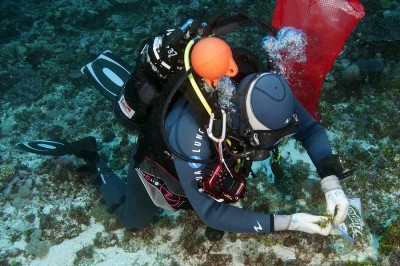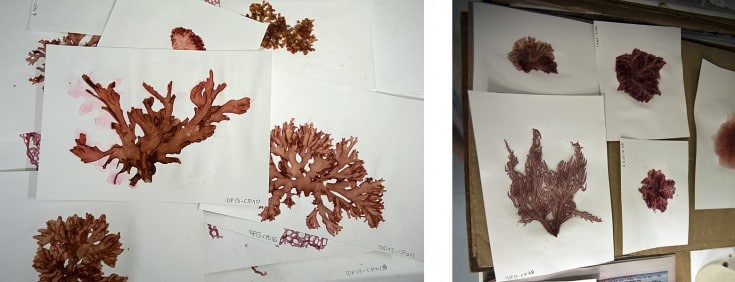A key aspect of the work being done during the GRE involves the characterization of the diversity (number of different species) of different organisms – fish, corals, other invertebrates and algae. While species inventories for algae have been completed here, much less is known about biodiversity of these algae, which is the focus of Claude Payri’s work… algal biodiversity. Her focus is on two groups of algae – certain green algae (the group Bryopsidales which includes Caulerpa, Halimeda and Codium) and the gelatinous red algae (Halymeniales). She is interested in characterizing the different algal species, including the amount of heritable variation within and between algal populations, evolutionary relationships between populations, and effects of the environment on these populations.
Studying Algal Biodiversity: What Algae Samples Reveal About Algal Populations
In the field, Claude collects multiple specimens of each alga from different depths and locations in order to determine algal biodiversity.

Claude Payri collecting algae samples to study algal biodiversity.
On the Golden Shadow, Claude first presses several algae samples onto special herbarium paper for a reference collection. Small pieces of tissue are placed between filters in ziplock bags containing silica gel (a dessicant) to dry the algae samples. Another set of tissue samples are placed in small vials containing ethanol for genetic work, and the last set is preserved in formalin. The preserved specimens are processed for histology, where tissue sections are examined under a microscope to examine the morphology and cellular structure.

Claude Payri pressing algae samples onto herbarium paper.
This algal study is part of a larger study, with algae samples from New Caledonia compared with samples she collected in Fiji, Vanuatu, Solomon Islands, Papua New Guinea, French Polynesia, Australia and New Zealand.

Herbarium paper samples used as part of the algal study.
Claude has already learned that algal communities in New Caledonia exhibit a high diversity, with only 25% overlap in species between the east and west sides of Grande Tierre. This is mainly due to temperature differences. Water off the east coast is warmer and supports more tropical algal species while water around Ile des Pins and off the west coast is colder. The cold water regions share most species with New Zealand and Lord Howe Island. Interestingly, tropical species are most closely linked with algal populations from five of the countries listed above, but are distinct from Australian populations.
Photos: 1-6 Ken Marks
